Radiography and Radiology
Master the INBDE with Dental Panda: Your go-to resource for expert practice exams and tailored study resources!
Table of Contents
- Radiographic equipment and settings
- Fundamentals of radiographs
- Factors that determine image quality
- Factors affecting x-rays
- Dental radiographic image detectors
- Film radiographs vs. digital imaging
- Measuring radiation exposure
- Radiation dose
- Intraoral radiography
- Bisecting angle and paralleling technique
- SLOB rule
- Clinical interpretation dental radiographs
- Extraoral radiography
- Lateral cephalometric projection
- Reverse Towne’s view
- Submentovertex view
- Waters view
- Features of orthopantomogram
- Types of radiography
- Radiography and pregnancy
Radiology involves the use of medical imaging to diagnose diseases and guide dental treatment. Radiography is an imaging technique using ionizing electromagnetic radiation (usually x-rays) to view objects inside the body or teeth. In radiographic imaging, a linearly propagating wave forming a divergent beam is both partly transmitted and partly absorbed by the area under investigation showing the structure by varying thickness and density.
A radiographic change will not begin to manifest until demineralization extends through the cortical plate of the bone. More than 30% of bony destruction is required to become visible on a radiograph, meaning the absence of radiographic signs of pathology does not mean the absence of pathology. The pulpal status cannot be determined by radiographic images alone.
The type of radiograph indicated depends on what is sought. A posterior bitewing radiograph is most beneficial for detected coronal caries or other causes of pulpal inflammation. If periapical pathology is suspected, a periapical radiograph is indicated. All radiographs should be taken with a holder to allow for reproducible parallelism and standardization. Specific areas to inspect include:
- Periradicular area – lesions of pulpal origin present as the loss of lamina dura apically. The inflammatory process must spread to the cortical bone to be visible.
- Pulpal area – internal resorption or calcification may indicate long term irritation. Pulp canal obliteration (canal calcification) does not necessarily indicate a need for treatment.
RADIOGRAPHIC EQUIPMENT AND SETTINGS
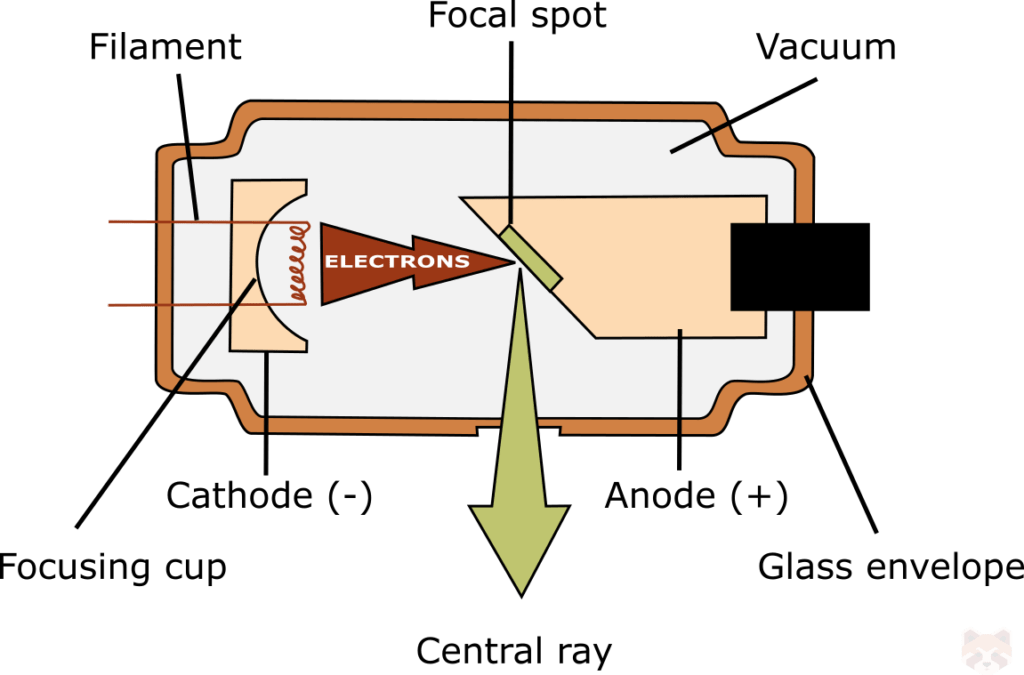
The dental x-ray unit tube is surrounded by a glass housing that holds a vacuum and sealed by an aluminum or plastic frame. The glass prevents radiation from escaping. The x-ray source consists of two electrodes, the anode (positive) and cathode (negative). The cathode filament is heated up to emit electrons which are accelerated toward anode by applying a 20–200 kV potential in a vacuumized x-ray tube. A focusing cup magnetically focuses the electrons into a narrow beam directed at a small area on the anode (focal spot). Between the cathode and anode is a tungsten target, which when hit produces x-rays. This process produces an enormous amount of heat. The vacuum prevents combustion and provides a clean environment for electron conduction.
Kilovoltage (kV) refers to the unit of measure of electrical potential between the anode and cathode. Adjusting the kV of a dental x-ray unit will affect both contrast and density. A higher kV will impart more energy to the electrons as they travel between the two points and produce more penetrating beams, with a higher percentage of radiation reaching the film. If the kilovoltage is lower the resulting film will have higher contrast but reduced density. If the kilovoltage is higher the resulting film will have lower contrast but increased density. Most dental units operate at around 70kV.
Milliamperage (mA) is a major factor in determining the quantity (number) of x-rays produced. If the mA is too low the quantity of x-rays reaching the film will be lower, and the film will be under-exposed (low density). If the mA is too high the quantity of x-rays reaching the film will be higher, and the film will be over-exposed (high density). The relationship between milliamperage and exposure time is a direct one. For example, radiographs obtained with a setting of 0.1 sec and 100 mA are identical to those obtained with a setting of 1.0 sec and 10 mA, assuming that all other factors remain constant.
Exposure time is a measure of how long the x-ray tube is “on”. Low quality long-wavelength x-rays are absorbed via aluminum discs in the x-ray tube (filtration). The shape of the beam emitted also reduces radiation exposure. Proper collimation is used to prevent unnecessary exposure outside the area of interest and improves image quality by producing less scatter radiation. Rectangular collimators limit the size and shape of the beam to just larger than the x-ray film to reduce unnecessary patient exposure.
Density is a visual characteristic of x-ray images that describes the overall darkness of the image (degree of silver blackening). An image with a proper density will show black areas (air spaces), white areas (enamel, amalgam) and gray areas (soft tissue, cancellous bone) properly. An increase in density will be noted if:
- kV is increased.
- mA is increased.
- Exposure time is increased.
- Thickness of the subject is decreased.
Contrast refers to the difference in the degree of blackness (densities) between adjacent areas on a dental radiograph. A ‘high contrast’ radiograph has very dark areas and very light areas. A radiograph that instead has many shades of gray is said to have a ‘low contrast’.
The focal spot refers to the area on the anode (tungsten wire) hit by electrons to produce x-rays. The focal spot can also be referred to as the target. The size of the tungsten target ranges from 0.5-1.0mm and is a set parameter of the device (cannot be changed). The smaller the focal spot, the sharper the image.
The target-film distance refers to the distance between the x-ray film and the anode. Decreasing the target-film distance increases the magnification of the object and increases the density. A shorter target-film distance requires less radiation to produce an adequate exposure. If minimizing radiation was the primary aim, an 8 inch x-ray tube would be preferred. However, a shorter tube will be less effective at eliminating divergent x-rays, leading to increased magnification and less diagnostic quality (loss of clarity). The rectangular area projected outwards to produce an x-ray field is known as the effective focus.
FACTORS THAT DETERMINE IMAGE QUALITY
Radiographic image quality depends on:
- Secondary radiation – fog and scatter.
- Focal spot size – the smaller the focal spot, the sharper the image produced.
- Object-film distance – decreasing the object-film distance increases sharpness.
- Target-object distance – the larger the target-object distance, the sharper the image.
- Motion – loss of sharpness if the patient moves during the exposure time.
- Exposure time – faster exposure time will result in a sharper image.
In order to take accurate, reproducible radiographs, it is recommended to:
- Use the smallest focal spot size.
- Use the shortest object-film distance to prevent distortion.
- Use the longest target-film distance (longer tube) to reduce divergent x-rays.
- Position the x-ray tube at 90° to the object.
- Keep the object and film parallel.
Possible reasons for an under-exposed film:
- Low kilovoltage.
- Low milliamperage.
- Low exposure time.
- High target-object distance.
Possible reasons for an over-exposed film:
- High kilovoltage.
- High milliamperage.
- High exposure time.
- Low target-object distance.
IMAGE DETECTORS
Digital radiography dominates the industry, usually producing better images using less radiation. Direct digital receptors include the charged-couple-device (CCD) and the complementary metal oxide semiconductor active pixel sensor (CMOS-APS). Indirect digital receptors include the storage phosphor plates (SPP).
Charged coupled devices (CCD) use silicon wafers whose crystals are formed in a picture element matrix. X Rays are converted to light using a scintillating screen, and the light is converted to an electric charge that is read by the sensor. The size of each pixel varies from 20 microns to 70 microns. CCD sensors are usually attached to a computer with a cable and are thicker than phosphor plates.
Photostimulable phosphor plate (PSP) or storage phosphor plate (SPP) technology captures the image in an analogue format which is then converted to a digital format. SPP has a polyester base coated with a crystalline europium-activated barium flouro-halide emulsion that converts the x-rays into stored energy. The energy is released as fluorescent blue light when the plates are scanned using a helium-neon laser.
The “speed” of the film refers to the amount of radiation required to expose a usable image. F-speed film is faster (requires less exposure) than E-speed, and E-speed is faster than D-speed. To minimize ionizing radiation exposure the fastest speed film should be used. Switching from D to E-speed film will lead to a 30-40% reduction in exposure. Switching from E to F-speed film will lead to a 20-25% reduction in exposure. Switching from D to F-speed film produced a 60% reduction in exposure.
MEASURING RADIATION EXPOSURE
Primary radiation refers to the main central beam produced by the xray unit. Any beam produced after the collision of the main beam (scatter) is termed secondary radiation. Intensifying screens are used to “boost” a signal in order to reduce the amount of radiation exposure required to achieve a comparable exposure. Radiation exposure can be measures in several ways:
- The amount of radiation being emitted by a radioactive material is measured using the conventional unit curie (Ci) or the SI unit becquerel (Bq).
- Gray (Gy) – a SI derived unit of absorbed radiation dose (energy absorbed by tissue). 1 Gy = one joule of radiation energy per kilogram of matter (1J/kg). 1Gy = 100 rads.
- Rad – a CGS unit of absorbed radiation dose (energy absorbed by tissue). The “erg” is a unit of energy equal to 10−7 joules (100 nJ). One rad is equal to the deposition of 100 ergs/g of tissue. 1 rad = 0.01 Gy.
- Sievert (Sv) – a SI unit used to estimate potential health effects of low levels of ionizing radiation on tissues/organs within the human body. The dose equivalent unit is a product of the radiation absorbed dose (Gy) and the quality factor (QF) which is specific for the radiation type (1 Sv = Gy x QF). 1 Sv = 100 rem.
- Roentgen equivalent man (rem) – a CGS unit used to estimate potential health effects of low levels of ionizing radiation on tissues/organs within the human body. The dose equivalent unit is a product of the radiation absorbed dose (Gy) and the quality factor (QF) which is specific for the radiation type. The SI (metric) equivalent is the Sievert (Sv).1 REM = 0.001 Sieverts
INTRAORAL RADIOGRAPHY
Radiopaque areas are created when more dense objects (metal, amalgam, enamel, dentine, gutta-percha etc.) inhibit x-rays, under-exposing the corresponding area on the film to produce a lighter image. A completely radiopaque material like amalgam will be represented by a completely white area on the film.
Radiolucent areas are created when less dense objects (pulp chamber, PDL space, cancellous bone, periapical abscesses or cysts etc.) allow more x-rays to pass through, over-exposing the corresponding area of the film to produce a darker image. A completely radiolucent area like an empty space will be represented by a completely black area on the film.
Cervical burnout refers to radiolucent areas interproximally near the cervical areas, caused by decreased x-ray absorption in these less-calcified areas. Cervical burnout is normal radiographic finding that can be confused for pathology (root surface caries).
Foreshortening is when the radiographic image appears shorter than the actual object being radiographed. The only way this can happen is if the central ray and image receptor are perpendicular, and the object being radiographed is angled.
Elongation is when the radiographic image appears longer than the actual object being radiographed. There are several situations where this can happen:
- If the central ray is perpendicular to the object, but the film is angled.
- If the object is parallel to the film, but the x-ray tube is angled.
- If the x-ray tube is off-center but perpendicular to the object (beam divergence).
Double exposure refers to multiple images superimposed on the same film. It is often the result after multiple exposures on a single (phosphor plate) film before processing. Cone cutting happens when the central ray is not lined up with the film and the collimator causes part of the image to be “cut off”.
A ghost image is a radiographic artifact found on panoramic x-rays, produced when an unintended object is scanned twice by the rotating x-ray beam. Commonly seen when earrings are left in place, the ghost image will resemble the in-focus object, but will be larger, out of focus, and on the opposite side.
The most commonly used and preferred (most accurate) radiographic technique is the paralleling technique, where the film is held parallel to the long axis of the tooth, producing the most accurate 2D representation of the object. However this is not always possible, likely due to anatomical restrictions. The bisecting angle technique is used as a compromise, where the central ray is oriented perpendicular to the bisecting line made from the angle of the film to the object. Using this technique will keep distortion to a minimum.
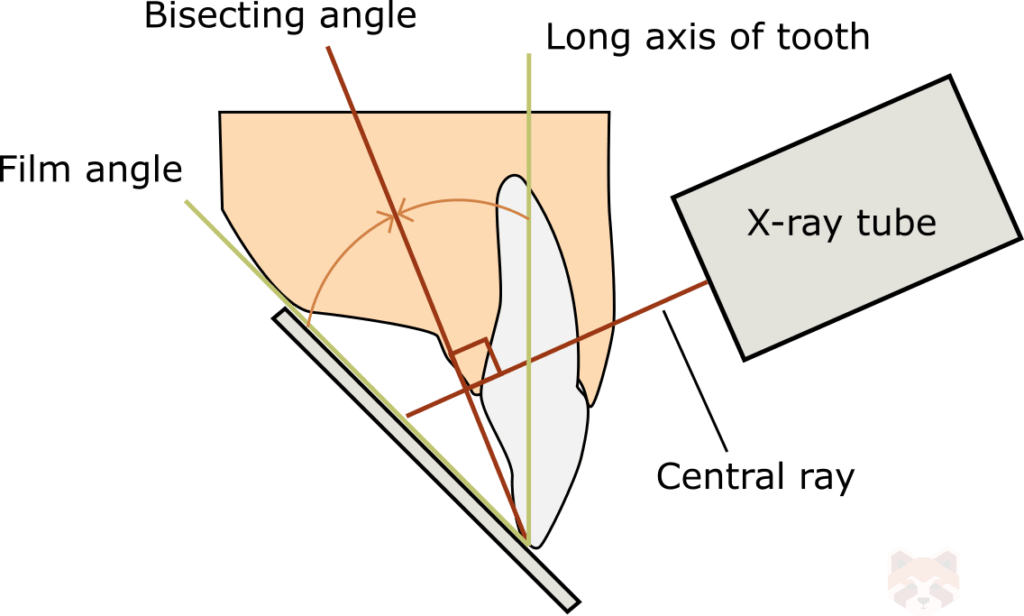
An intentional second film at a divergent angle can be useful to get a 3-dimensional representation of the structures within an area. The SLOB rule can be used to determine the relationship between two objects. SLOB is an acronym that stands for Same Lingual Opposite Buccal. If the object moves in the same direction of the x-ray tube the object is lingual (palatal) to the reference point. If the object moves in the opposite direction of the x-ray tube the object is buccal (labial) to the reference point.
Posterior bitewings are perhaps the most frequently used intraoral radiograph used in dentistry. A size 0, 1 or 2 periapical film is placed perpendicular to the occlusal plane with both mandibular and maxillary teeth in view. The vertical angulation of +8-10° coincides with the occlusal plane and avoids the overlapping of cusps. Bite tabs or a film/sensor-holding device is used for accurate positioning and to line up the x-ray tube. The central ray is directed perpendicular to the film. Posterior bitewings are used to:
- Diagnose caries (especially interproximal) and alveolar bone loss.
- Assess crown and restoration margins.
Periapical radiographs are perhaps the second most frequently used intraoral radiograph used in dentistry. A size 0, 1 or 2 periapical film is placed perpendicular to the tooth/teeth that are being investigated. The vertical angulation may be required due to anatomical restrictions, but is avoided if possible. A film/sensor-holding device is used for accurate positioning and to line up the x-ray tube. The central ray is directed perpendicular to the film. Periapical films are used to:
- Detect apical infection/inflammation.
- Assess periodontal structures.
- Review trauma to the teeth and associated alveolar bone.
- Assess the presence and position of unerupted teeth.
- Assess root morphology before extractions.
- Diagnose and treat a tooth endodontically.
- Preoperatively assess and postoperatively review apical surgery.
- Evaluate apical cysts and other lesions within the alveolar bone.
- Evaluate implants.
EXTRAORAL RADIOGRAPHY
It is wise to be aware of common extraoral radiographic techniques. However, 2 dimensional radiographs are slowly becoming obsolete, slowly replaced by more accurate and versatile 3D (CT) scans.
The orthopantomogram (aka orthopantomograph, pantomogram, OPG or OPT) is a panoramic single image radiograph of the mandible, maxilla and dentition. The image is a three-dimensional curved focal trough flattened out to a two-dimensional image. Structures lying within the focal trough are well-defined and in focus. Structures outside the focal trough are blurred, magnified, and sometimes distorted. The patient remains seated or standing while both the x-ray source and the film rotate around the patient’s head. The x-ray source rotates in front of the patient, the film rotates opposite to the x-ray source behind the patient. It takes a few seconds during which the patient must remain completely still. Orthopantomograms are most commonly used in dental practice and occasionally in the emergency department. The OPG is used to:
- Evaluate general dental health & development.
- Screen for caries, pulpal pathology, impaction etc.
- Assess jaw trauma or pathology.
- Review infection or inflammation (sinusitis, periodontitis, periapical abscesses etc.).
- Evaluated tumors or cysts.
- Assess temporomandibular joints for disease, fractures or dislocations.
- Localize foreign bodies.
- Identify salivary stones (sialolithiasis).
- Monitor growth and development.
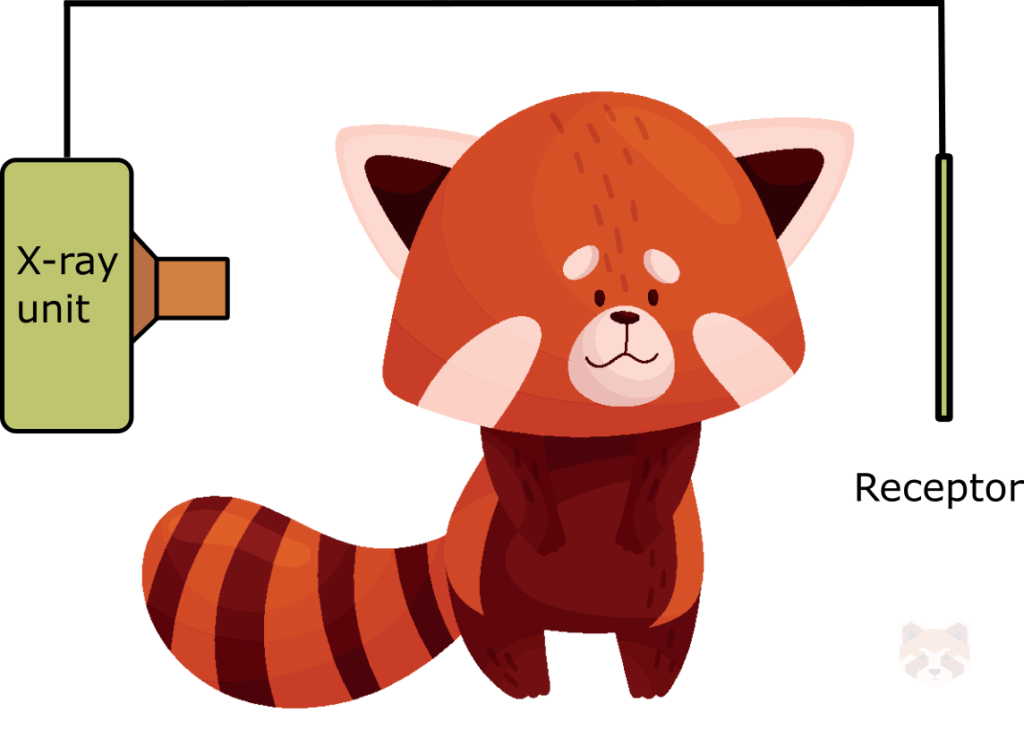
The skull lateral view (lateral cephalometric projection) is a non-angled lateral radiograph of the head that provides an overview of the entire skull, as well as a soft tissue profile of the face. The patient’s head is positioned so that the median sagittal plane is parallel to the film plate. The central ray is targeted roughly 5cm superior to the external auditory meatus. The image should contain all bones in the head and the first cervical vertebrae. The lateral view is used for:
- Cephalometric analysis and craniofacial growth (orthodontics).
- Skull fractures evaluation.
- Neoplastic screening.
- Bone abnormalities assessment (e.g. Paget disease).
- Trauma evaluation (e.g. basal skull fracture).
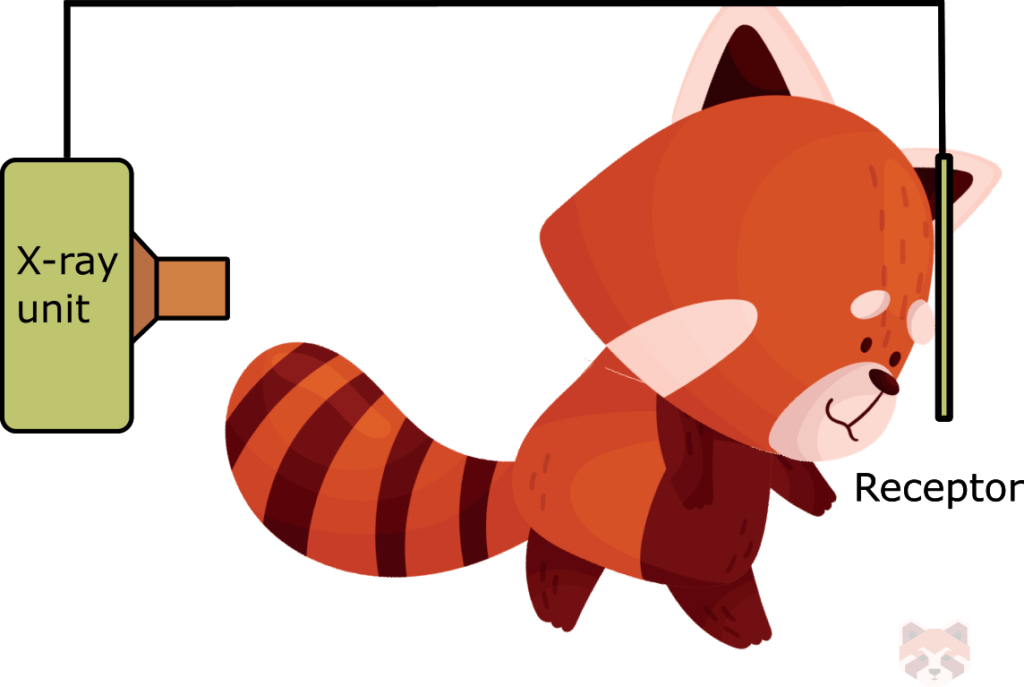
The Towne view is an angled anteroposterior radiograph of the skull. The patient’s head is positioned with the nuchal ridge against the image detector and the infraorbitomeatal line perpendicular to the image receptor. The central ray is angled 30° superior from the Frankfort plane with the film behind the patient’s head, passing midway between the external auditory meatuses approximately 4cm above the glabella. The Towne view is used to:
- View the condylar head and the ramus of the mandible.
- Evaluate medial and lateral displacements of skull fractures.
- Screen for neoplastic changes.
- Review bone abnormalities (e.g. Paget disease)
- Reverse Towne’s view offers diagnostic images of condylar neck and ramus fractures.

The submentovertex view is an angled infero-superior radiograph of the base of the skull. The patient’s neck is hyperextended until the infraorbitomeatal line (IOML) is parallel with the receptor and the skull vertex is in contact with the center of the receptor. This technique is not widely used due to the awkward patient positioning and advances in CT scanning. The submentovertex view is used to:
- Identify the position of the condyles.
- Assessing pathology or trauma associated with the base of the skull.
- Evaluating the zygomatic complex.
- Viewing the ethmoid and sphenoid sinuses, and the lateral wall of the maxillary sinus.

The occipitomental (OM) or Waters view is an angled postero-anterior radiograph of the skull, with the patient looking slightly upwards. The patient’s head is positioned with the chin raised until the mento-mandibular line (MML) is perpendicular to the receptor, which itself is perpendicular to the floor. The central ray is directed perpendicular to the film. The Waters view is used to:
- Obtain diagnostic views of the maxillary and paranasal sinuses (acute sinusitis).
- Assess for facial fractures, especially around the orbits and nasal cavity.
RADIOGRAPHIC ANATOMY
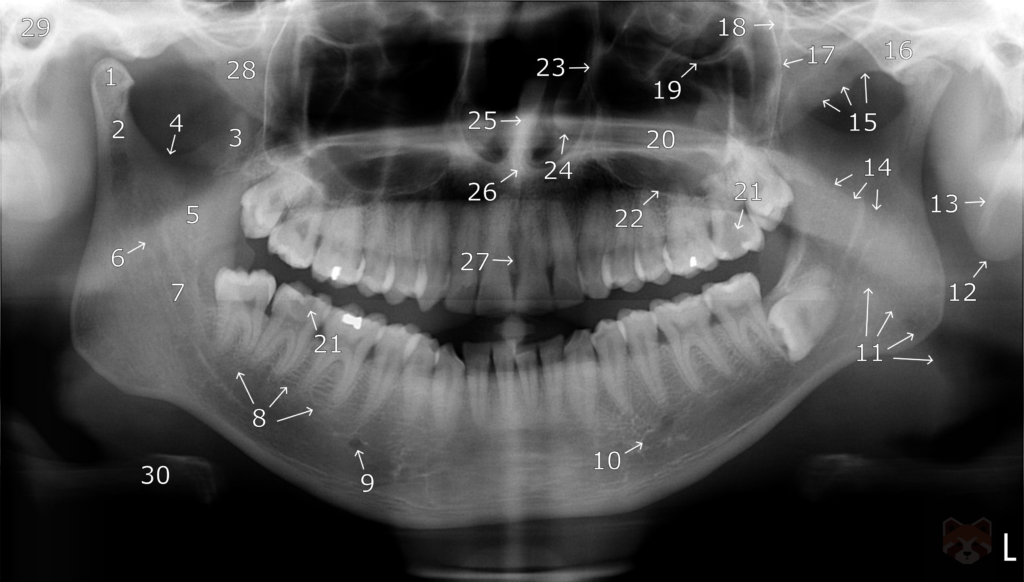
- Condylar head.
- Condylar neck.
- Coronoid process.
- Sigmoid notch.
- Mandibular ramus.
- Mandibular nerve foramen.
- Inferior alveolar nerve canal.
- Submandibular gland fossa.
- Mental nerve foramen.
- Anterior loop of the mental nerve.
- Dorsum of the tongue.
- Auricle (ear).
- Styloid ligament.
- Soft palate.
- Zygomatic arch.
- Articular eminence.
- Posterior wall of the maxilla.
- Pterygomaxillary fissure.
- Floor of the orbit, roof of the maxillary sinus.
- Hard palate.
- Occlusal caries.
- Floor of the maxillary sinus.
- Lateral wall of the nasal fossa, medial wall of the maxillary sinus.
- Inferior concha.
- Nasal septum.
- Anterior nasal spine.
- Incisive (nasopalatine) canal.
- Pterygoid plates.
- External auditory meatus.
- Hyoid bone.
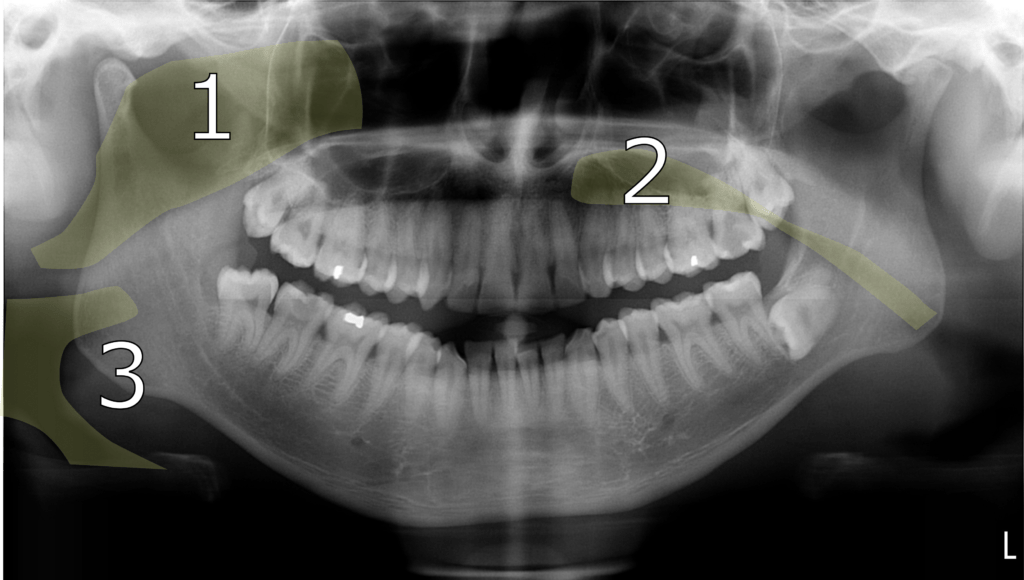
- Nasopharyngeal airspace – posterior to the nasal cavity.
- Palatoglossal airspace – between the palate and the tongue.
- Glossopharyngeal airspace – posterior to the tongue and oral cavity.

- Maxillary sinus floor.
- Extruded gutta-percha.
- Lamina dura.
- Bony trabecula.
- Internal restorative void.
- Enamel of the disto-lingual cusp of the maxillary first molar.
- Film holder
PREGNANCY
There has been no recorded incidents of damage to a fetus from dental radiography. During pregnancy (like at all times) radiographic examinations are kept to a minimum consistent with the mother’s dental needs. A radiograph is acceptable whenever a reasonable diagnostic requirement exists.
A thyroid shield and apron can be used to limit exposure to radiation scatter. To shield dental personnel from unnecessary exposure it is recommended that staff stand behind a barrier. If no barrier is feasible, staff should stand at least 6 feet away from the x-ray tube, in an area around 90° (perpendicular) to the central ray.
